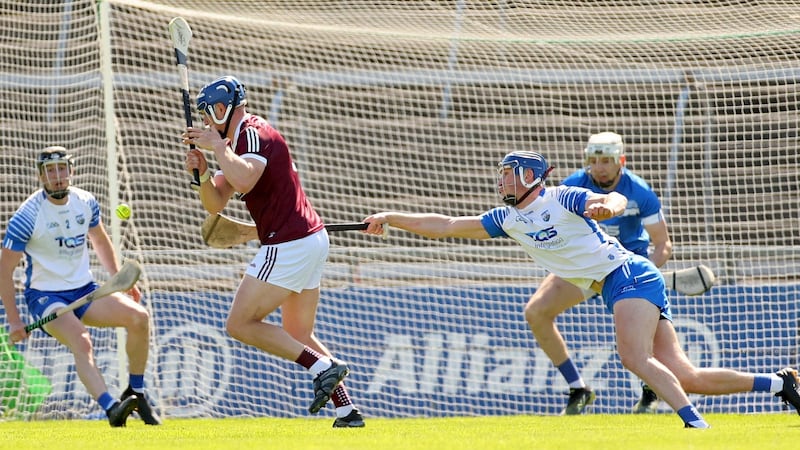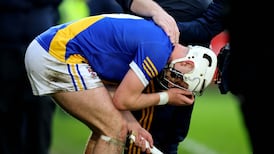There we were in Galway last Sunday after the final whistle, shaken by the torrential shooting, which threw up a scoring attempt roughly every 50 seconds, and examining bits of paper with our hieroglyphics to see what we’d managed to record.
In response to one of the conventional, post-match topics of conversation, Micheál Clifford from the Daily Mail was first to offer an opinion. “My man of the match,” he declared, “was the fella operating the scoreboard.”
Not surprisingly, the Galway and Waterford managers were less concerned by the overall scoring rate than their own concession rate. But from a spectator’s perspective, there may be such a thing as too much scoring and by extension too few contests, whether for actual possession or between defender and attacker.
Already scoring in this season’s league is well outstripping last season in both of the Division 1 groups. After four series of fixtures among all but one of the same counties, the aggregate scoring is 67-1069 to 57-845, a difference of nearly half a goal and more than nine points per match.
The points average to date is 44.5, which maybe appears reasonable, around 0-22 apiece, but to give it context, there have been five All-Ireland finals in history that have exceeded 44.5 points in total and four were within the past seven years.
Prior to 2014, there was only one All-Ireland final that featured an aggregate of 0-45 or more. There is little a defence can do when a player finds himself some space within 80 or 90 metres of the posts.
There are other factors. Last season’s league was played in the usual hideous January to March window and the weather would have been less sympathetic to scoring than this year’s competition, particularly in the last couple of weeks, which has seen full-on championship weather but without the peak fitness.
None of this is earth shattering disclosure. It’s been in development over the past decade.

Speaking at the launch of his broadcaster’s championship coverage, Sky analyst James O’Connor made some interesting comments on scoring trends.
“Long term that is something that has to be a concern given the sweet spot on the hurley is getting better. As athletes, players are incredibly well-conditioned now. All of these factor into that.”
A few years ago, a prominent intercounty player was asked in a convivial setting had he ever had anyone measure the bas on his hurley. He hadn’t and no surprise there because the GAA has apparently abdicated responsibility for the regulation of equipment.
In part 2 of the Official Guide, rule 4.5 states: “The bas of the hurley at its widest shall not be more than 13 centimetres”.
With an implicit policy of not enforcing this, the GAA has fed into the current situation. As O’Connor said, the sweet spot (optimum for striking) is now so much larger. One senior GAA official estimates that the width of the bas in some cases is now clocking in at around 18cm – nearly 40 per cent in excess of what’s allowed.
That’s a lot of additional – and irregular – firepower.
The length of a stick has never been regulated, for obvious reasons, but the old rule of thumb was that it should come up to more or less a player’s hip, an average of around 36 or 37 inches (91 to 94cm). It is currently estimated that the new preference for shorter sticks has reduced to as little as 32 or 33 inches (81 to 84cm). That’s a drop of 10 centimetres.
It’s almost as if the stick has evolved to reflect what is effectively the extinction of both ground hurling and overhead striking.
If the regulations on the dimensions of a hurley are routinely overlooked, so too the restrictions on the hand pass. There is almost a gasp from the crowd – or whoever’s in attendance – when a hand pass is whistled as a throw. The use of the holding hand even with a ‘definite striking action’ to pass the ball has led to irregularities largely being overlooked.
Former Tipperary All-Ireland winning full back Conor O’Donovan has proposed that a hand pass should have to be struck with the other hand, ie the one not holding the ball, which would make the execution a lot easier to adjudicate.
There has been a lot of focus on composition of the sliotar, to make it heavier and more difficult to strike long distances. This comes with a caveat from the experience of baseball, which this year decided to alter its ball to make home runs harder to hit and keep the ball in play a bit more.
This has come with unintended consequences, which have triggered much debate in the US as to whether it’s having the desired effect and whether it’s over-balanced the game in favour of pitchers.
The hardy perennial of increasing the value of a goal would be another possibility. Goals used to be the basic scoring currency, not surprisingly given the difficulty of striking the old ball with its weight and absorbability over long distances.
No team has scored six goals in an All-Ireland for the past 50 years. It happened eight times in the previous half century to 1921 and nine times in the preceding 25 years back to 1896 which was when the goal was assigned its current value of three points.
Over the same period, rugby has made several changes to its scoring system to encourage play in various directions. Given the facility with which points are now struck, is it proportionate that goals are still worth just three times as much – as opposed to say, five?
No one, let alone the conservative hurling constituency, wants there to be a constant conveyor belt of rule changes and it’s likely the goal will retain its value for a while, whatever the evidence.
There are valid concerns about excessive scoring rates and allowing that the causes are multi-factorial why not start by enforcing the rules that are already there?
smoran@irishtimes.com
















